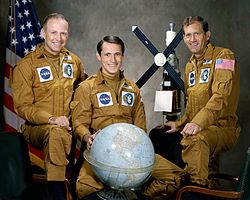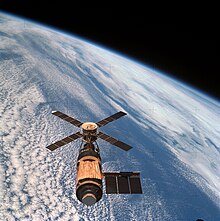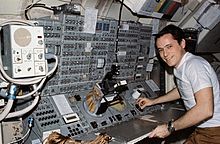Skylab 4
| Mission emblem | |||
|---|---|---|---|

|
|||
| Mission dates | |||
| Mission: | Skylab 4 | ||
| COSPAR-ID : | 1973-090A | ||
| Command module: | CM-118 | ||
| Service module: | SM-118 | ||
| Dimensions: | 20,124 kg | ||
| Launcher: | Saturn IB , serial number SA-208 | ||
| Call sign: | Skylab 4 | ||
| Crew: | 3 | ||
| Begin: | November 16, 1973, 14:01:23 UTC | ||
| Starting place: | Kennedy Space Center , LC-39B | ||
| Space station: | Skylab | ||
| Coupling: | November 16, 1973, 21:55:00 UTC | ||
| Decoupling: | February 8, 1974, 02:33:12 UTC | ||
| Duration on Skylab : | 83d 4h 38m 12s | ||
| Number of EVA : | 4th | ||
| Landing: | February 8, 1974, 15:16:53 UTC | ||
| Landing place: | Pacific , 31 ° 18'N, 119 ° 48'W | ||
| Flight duration: | 84d 1h 16m | ||
| Earth orbits: | 1214 | ||
| Recovery ship: | USS New Orleans | ||
| Rotation time : | 93.2 min | ||
| Apogee : | 227.08 km | ||
| Perigee : | 150.1 km | ||
| Covered track: | 55.5 million km | ||
| Team photo | |||
 v. l. No. Gerald Carr, Edward Gibson, William Pogue |
|||
| ◄ Before / After ► | |||
|
|||
Skylab 4 ( SL-4 ) was the third and final crew of the US Skylab space station . It set new records in space travel and marked the end for US space stations.
The team
Together with the Skylab 2 and Skylab 3 crews, NASA announced the Skylab 4 crew on January 19, 1972 . The command should Gerald Carr accept. William Pogue was assigned as the pilot and the science astronaut Edward Gibson completed the trio. What was unusual was that the command was given to an astronaut with no space experience. This award was last given to Neil Armstrong on the flight of Gemini 8 in 1966 .
As with Skylab 3, the replacement crew consisted of the commander Vance Brand , the pilot Don Lind and the scientist William Lenoir . The support crew for all three Skylab missions was Robert Crippen , Richard Truly , Henry Hartsfield and William Thornton .
The mission was officially called Skylab 4 (SL-4), but was often also called Skylab 3 (SLM-3) because it was the third manned mission of the space station.
The preparation
The individual parts of the Saturn 1B rocket AS-208 were delivered to the Kennedy Space Center between November 1971 and June 1973 . On August 6, 1973 the Apollo (spaceship) CSM-118 was assembled, and on August 14, the rocket could be transported to launch pad 39B.
The launch was initially scheduled for November 11, 1973, but five days before that date, cracks were found in all eight stabilizing fins of the rocket. The fins had to be replaced, so the start was postponed. The extension of the flight compared to the initially planned 58 days also required numerous items of equipment, food and films to be stowed in the capsule.
Flight history
Skylab 4 took off from Cape Canaveral on November 16, 1973. After about eight hours, the Apollo spacecraft was able to dock at Skylab.
After the experience with the space sickness of the second team, the flight control had decided that the astronauts should spend the first night on board Apollo, because apparently the weightlessness in large, open spaces promotes space sickness.
That evening, Pogue vomited while Skylab was out of radio range of the ground stations. The astronauts feared that the doctors would attach too much importance to this incident, and the mission would be delayed or perhaps even canceled. So Carr only reported Pogue's discomfort, not mentioning that Pogue had vomited. The astronauts had forgotten that the conversations in the cockpit were automatically recorded and transferred to the ground stations with a time delay. In this way, the flight control learned the true facts the next day, which Carr brought a reprimand from chief ronaut Alan Shepard .
The outstanding work performance of the second team had set new standards, so that flight control packed the mission's work program quite tightly. A few new experiments were added, and the newly discovered comet Kohoutek offered sensational observation opportunities. The crew also struggled with technical difficulties, in particular the partial failure of the attitude control endangered the continuation of the mission. The problem was solved by improving the operating conditions.
There was not a good relationship between the astronauts and flight control on Earth. A crowded daily routine left the astronauts little free time. It turned out that the time constraints for various tasks had been assessed too optimistically. In some cases, the astronauts had to set up experiments that they had never seen before. The team felt overwhelmed. However, a clarifying discussion came relatively late, on the 45th day of the mission. The occasional statement that the team took a day off without permission was later contradicted by Carr, however, pointing out that they had voluntarily given up several days off in order to catch up on time delays.
The team carried out four space missions with a total of over 22 hours, each of which involved two astronauts. Work on the space station on December 25th set a new record with seven hours and one minute.
An important part of the scientific work was the observation of comet Kohoutek, which had only recently been discovered. Among other things, it was possible for the first time to detect water in the comet's core by spectroscopy.
On February 8, 1974 , Carr, Pogue and Gibson boarded the Apollo spacecraft. While still docked, they fired the RCS thrusters twice for a total of three minutes to bring Skylab into higher orbit . According to NASA calculations, this should provide nine more years in orbit. Some food as well as clothing and equipment remained on board. Should one enter the space station again before the crash (the first launch of the space shuttle was planned for five years later), one could investigate the effects of long-term storage.
Shortly after the re-entry brake rockets were fired , Carr noticed that the control engines were not responding, so he had to switch to a backup system. It later emerged that some switches had previously been operated incorrectly. This incident showed that it was not entirely safe to stay on board a space station for twelve weeks without occasionally training to control the spaceship.
The whereabouts of the flight hardware
The Skylab 4 CM is on display at the National Air and Space Museum in Washington DC.
Significance for the Skylab project
From a scientific point of view, the third Skylab mission was also a complete success. The astronauts brought a lot of valuable scientific data back to Earth, including images of a comet that cannot be photographed from Earth in this way. In addition, the solar observatory was able to photograph a protuberance in its development phase for the first time .
Skylab 4 had broken the long-term record of Skylab 3 . At 84 days, Carr, Pogue and Gibson held the record for the longest space flight, but also the record for the entire flight duration of a space traveler. It was not until 1978 that Georgi Grechko and Yuri Romanenko were supposed to stay longer in space on board Salyut 6 .
Skylab's long-term missions also contributed to the fact that the public's fascination with manned space travel waned. For the first time, the splashing of an Apollo flight was not broadcast live on television.
Skylab was to remain the only American space station. It was not planned to repeat this project, and NASA now focused on developing the reusable space shuttle that would replace the missile rockets in the late 1970s. Before that, the Apollo-Soyuz test project was planned, in which an American Apollo spacecraft was supposed to dock with a Soviet Soyuz spacecraft . That would end the Apollo era.
Psychological problems on long-term missions
When the work performance of the three teams in their third and fourth week was compared after the end of the project, no significant difference was found. The third team had also achieved more than was planned.
However, there were serious differences in the personalities of the three teams. The repairs that were necessary during the first crew created a certain pioneering feeling, while the second crew concentrated on their work and took little free time. With the third team there was most tension and unspoken problems weighed on the project. None of the astronauts on the third team was nominated a second time for a space flight.
Three reasons contributed to this conflict. First, there is the heavy workload. The third Skylab team did not have a longer working day than the two previous teams, but had to provide this performance not just over one or two, but over three months. Second, trust between flight control and crew was strained from day two when the astronauts failed to report Pogue's space sickness. Third, there were always inevitable technical inadequacies on board, which the crew became increasingly annoyed with over time. The resulting dissatisfaction then emerged in the discussions with the flight control.
Overall, parallels can be drawn to the flight of Apollo 7 . The astronauts Schirra , Cunningham and Eisele were also exposed to a high workload on the first flight of the Apollo spacecraft in October 1968. In addition, the astronauts were irritated by a cold and feared permanent health damage if they returned. In contrast to the Skylab crew, however, the different points of view were immediately brought up over the radio.
Skylab remained the only American space station, but the experience could also be used for missions on board the Soviet Mir and the international space station ISS . It turned out that the astronauts must have a good balance between work and leisure, which depends on the mission profile and duration. Furthermore, the astronauts, but also experienced ex-astronauts, must be heavily involved in the mission planning. A good personal relationship with the flight control staff is also important. Of course, the mission planning must also provide enough alternatives in order to be able to react flexibly if certain work is carried out faster or slower than planned.
In future space travel, for example a manned flight to Mars , not only work overload can become a problem, but also boredom during flight phases when there is little for the crew to do.
Ultimately, the composition of the team also plays a major role. Fortunately, the astronauts on all three Skylab teams got along very well with each other, so there were no major tensions on board.
See also
literature
The following NASA books (all in English) are available online:
- Skylab, Our First Space Station
- Living and Working in Space: A History of Skylab
- Skylab's Astronomy and Space Sciences
- A New Sun: The Solar Results from Skylab
- Skylab, Classroom in Space (describes the 25 science experiments designed by students)
Also on the NASA History Office website:
- Skylab: A Chronology
- Skylab: A Guidebook
- NASA Investigation Board Report on the Initial Flight Anomalies of Skylab 1
Web links
- Space facts: Skylab 4
swell
- ↑ D. Shayler, Around the world in 84 days - The authorized biography of Skylab astronaut Jerry Carr, Apogee Books, Burlington 2008, ISBN 9781-894959-40-7 , p. 162 and p. 166



